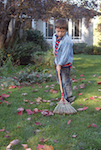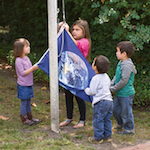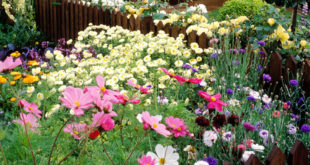 This is the year to make your school as green as possible! Create some new ways for you and your students to celebrate Earth Day. As April 22 approaches, get your students excited about doing even more to conserve our precious natural resources.
This is the year to make your school as green as possible! Create some new ways for you and your students to celebrate Earth Day. As April 22 approaches, get your students excited about doing even more to conserve our precious natural resources.
The Basics
It really makes a difference if you practice what you preach. The school sets an example for what we want the community to do. These basics are what many already practice:
- Separate recyclable items from trash.
- Choose to use cloth towels, napkins, and mats, rather than paper.
- Require students to bring lunch in re-usable containers, rather than in plastic or foil wrappers.
- Use real plates, glasses, and flatware for snacks and lunch.
- Encourage parents to carpool or walk their children to school as frequently as possible.

- Reduce car idling in the drop-off/pick-up lines whenever possible.
- Have a compost bin in the classroom for carrot peelings, and other food scraps that children can periodically add to the garden compost pile.
- Consider buying items for the classroom that are made from sustainable or recycled materials.
- Post a sign at the school entrance that says. “This is an Earth-care area,” and fly an Earth flag nearby.
Classroom Lessons
Many science lessons are already topics of environmental protection and awareness of the limited resources of Earth. The importance of trees and forests is the natural beginning of a lesson on how photosynthesis affects the air we breathe. How many trees would be saved if each person in the state would stop using paper napkins or paper towels? How much trash does one classroom generate in a day or week? Older children might experiment to determine how much water goes down the drain when brushing their teeth for two minutes, or research how renewable power keeps the air cleaner.
Earth Day is a wonderful opportunity for students to participate in community celebrations and projects. They might help plant flowers in the town center, visit the recycling plant, or help clean up the beach or parkways. Students can write letters to the town council or parks department asking them to provide separate containers for recyclables, or advocating for the reclamation of wetlands and forests.
A celebration might include planting a garden or a tree on the school grounds. Projects at home and in the community can be encouraged, as well. Each child might take home a seedling that he grew in school to be planted at home. Hiking into the woods with the children can be a lesson in protecting the pristine natural environment as they walk carefully and leave nothing behind.
The Bigger Picture
Review with your school board and local utility providers how you can make the physical plant more efficient. Do you have water-saving toilets and faucets? If there is an irrigation system, does it use recycled water? Would solar panels help reduce the cost of heat or air-conditioning? (Some solar companies will install the panels at no cost, and share in the cost savings over time to defray up-front costs.)
Does your school have a garden where children can grow some of their own food? Have you considered planting in large steel or wooden containers if there is no tillable land? Are there trees on the property to provide shade and reduce energy costs? Check into requirements for becoming designated as a “green” school. There are different levels of “greenness” and you may qualify for one.
Schools celebrate Earth Day as a reminder that what we do is important, and small steps can make a difference for all. We are protecting our resources, including our children, as we help make the future bright for all.
“The children never forgot to water the plants with a little watering can. One morning I found them all seated in a circle… around a magnificent red rose that had opened up during the night.”
—Mario Montessori, The Discovery of the Child
 Montessori blog Montessori blog
Montessori blog Montessori blog 
